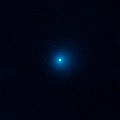File:Distant active comet C 2017 K2.jpg
頁面內容不支援其他語言。
外觀

預覽大小:600 × 600 像素。 其他解析度:240 × 240 像素 | 480 × 480 像素 | 1,000 × 1,000 像素。
原始檔案 (1,000 × 1,000 像素,檔案大小:447 KB,MIME 類型:image/jpeg)
摘要
| 描述Distant active comet C 2017 K2.jpg |
English: This Hubble Space Telescope image shows a fuzzy cloud of dust, called a coma, surrounding the comet C/2017 K2 PANSTARRS (K2), the farthest active comet ever observed entering the solar system. Hubble snapped images of K2 when the frozen visitor was over 2.4 billion kilometres from the Sun, just beyond Saturn's orbit. Even at that remote distance, sunlight is warming the frigid comet, producing a 128,000-kilometre-wide coma that envelops a tiny, solid nucleus. K2 has been traveling for millions of years from its home in the Oort Cloud, a spherical region at the edge of our solar system. This frigid area contains hundreds of billions of comets, the icy leftovers from the formation of the solar system 4.6 billion years ago. The image was taken in June 2017 by Hubble's Wide Field Camera 3. Links: NASA Press Release Schematic of comet C/2017 K2's approach to the Solar System |
| 日期 | |
| 來源 | https://www.spacetelescope.org/images/opo1740a/ |
| 作者 | NASA, ESA, and D. Jewitt (UCLA) |
授權條款
| ESA/Hubble images, videos and web texts are released by the ESA under the Creative Commons Attribution 4.0 International license and may on a non-exclusive basis be reproduced without fee provided they are clearly and visibly credited. Detailed conditions are below; see the ESA copyright statement for full information. For images created by NASA or on the hubblesite.org website, or for ESA/Hubble images on the esahubble.org site before 2009, use the {{PD-Hubble}} tag.
Conditions:
Notes:
|
此檔案採用創用CC 姓名標示 4.0 國際授權條款。
姓名標示: ESA/Hubble
- 您可以自由:
- 分享 – 複製、發佈和傳播本作品
- 重新修改 – 創作演繹作品
- 惟需遵照下列條件:
- 姓名標示 – 您必須指名出正確的製作者,和提供授權條款的連結,以及表示是否有對內容上做出變更。您可以用任何合理的方式來行動,但不得以任何方式表明授權條款是對您許可或是由您所使用。
說明
添加單行說明來描述出檔案所代表的內容
在此檔案描寫的項目
描繪內容
2 10 2017
檔案歷史
點選日期/時間以檢視該時間的檔案版本。
| 日期/時間 | 縮圖 | 尺寸 | 使用者 | 備註 | |
|---|---|---|---|---|---|
| 目前 | 2019年12月31日 (二) 09:09 |  | 1,000 × 1,000(447 KB) | BevinKacon | actual size from source |
| 2017年10月3日 (二) 13:10 |  | 1,280 × 1,280(269 KB) | Jmencisom | User created page with UploadWizard |
檔案用途
下列頁面有用到此檔案:
全域檔案使用狀況
以下其他 wiki 使用了這個檔案:
- ar.wikipedia.org 的使用狀況
- en.wikipedia.org 的使用狀況
- it.wikipedia.org 的使用狀況
- ru.wikipedia.org 的使用狀況
- uk.wikipedia.org 的使用狀況
- www.wikidata.org 的使用狀況
詮釋資料
此檔案中包含其他資訊,這些資訊可能是由數位相機或掃描器在建立或數位化過程中所新增的。若檔案自原始狀態已被修改,一些詳細資料可能無法完整反映出已修改的檔案。
| 影像標題 |
|
|---|---|
| 製作/提供者 | NASA, ESA, and D. Jewitt (UCLA) |
| 來源 | ESA/Hubble |
| 簡稱 |
|
| 使用條款 |
|
| 資料產生的日期時間 | 2017年10月2日 (一) 12:28 |
| JPEG 檔案備註 | This Hubble Space Telescope image shows a fuzzy cloud of dust, called a coma, surrounding the comet C/2017 K2 Pan-STARRS (K2), the farthest active comet ever observed entering the solar system. Hubble snapped images of K2 when the frozen visitor was 1.5 billion miles from the Sun, just beyond Saturn's orbit. Even at that remote distance, sunlight is warming the frigid comet, producing an 80,000-mile-wide coma that envelops a tiny, solid nucleus. K2 has been traveling for millions of years from its home in the Oort Cloud, a spherical region at the edge of our solar system. This frigid area contains at least 100 million comets, the icy leftovers from the formation of the solar system 4.6 billion years ago. During the comet's inward journey, gravitational tugs from the planets nudged it from its trajectory so that it is no longer gravitationally bound to the Sun. After K2 makes its closest approach to the Sun in 2022, it will leave the solar system forever. The image was taken in June 2017 by Hubble's Wide Field Camera 3. |
| 關鍵字 | C/2017 K2 PANSTARRS |
| 聯絡資訊 |
Karl-Schwarzschild-Strasse 2 Garching bei München, None, D-85748 Germany |
| IIM 版本 | 4 |
隱藏分類:



